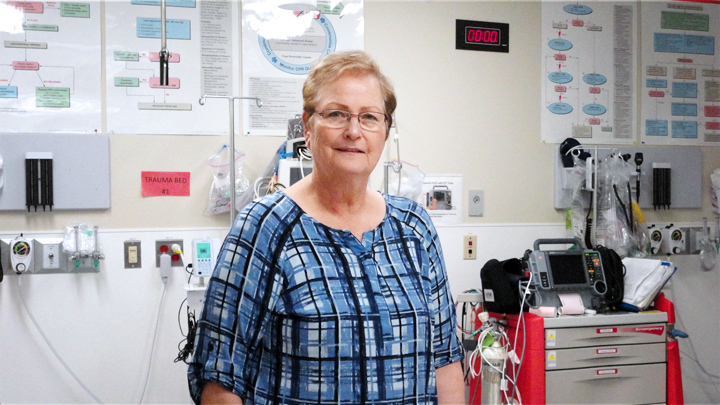
May 25, 2016
‘Thank God for Westlock,’ Ziegler says of the primary stroke centre, one of 13 in Alberta. ‘They brought me back.’ Stroke care teams at the Westlock Healthcare Centre work quickly to identify the type of stroke and administer treatment in under an hour of being called.

Janna Ziegler stands in a treatment room at the Westlock Healthcare Centre. The Athabasca woman says she’s grateful for the timely care she received, helping her recover from a stroke.
Story by Sara Warr; Photo by Jan Piliszanski
Janna Ziegler was casually flipping through a magazine in her living room when suddenly something didn’t seem right.
“I had just sat down. When I turned the page, one side was all different shapes and they were all squiggly and bright colours,” Ziegler recalls of that afternoon last November. “I called out to my husband to come upstairs and by the time he came up my left eye had totally shut. He said, ‘I think you’re having a stroke,’ and called an ambulance.”
EMS personnel quickly assessed Ziegler’s condition, determined she was likely experiencing a stroke caused by a blood clot in her brain and transported the 65-year-old to the Westlock Healthcare Centre, about 80 km away.
“Thank goodness they took me to Westlock,” says Ziegler. “They did a fantastic job there. They brought me back.”
Westlock is one of 13 rural primary stroke centres in Alberta. There, a team of specialized health care professionals is able to identify different types of strokes and, when appropriate, treat patients with a special clot-busting drug called tPA.
“We’ve worked diligently to get stroke care at our facility equivalent to that of urban centres,” says Kara Rimmer, Alberta Health Services (AHS) stroke services co-ordinator at the site, which cares for approximately 30 stroke patients a year.
A stroke is a sudden loss of brain function caused by a blockage of blood flow to the brain or the rupture of blood vessels in the brain. The interruption of blood flow to the brain causes brain cells – also known as neurons – in the affected area to die. Time is of the essence during a stroke. The sooner a patient receives treatment, the fewer brain cells will die and the better the patient’s outcome is likely to be.
With great health outcomes as its goal, Westlock, like other rural primary stroke centres, uses a multidisciplinary approach to stroke care. As the patient is being transported, EMS crews check the signs and alert the team at the health care centre, who perform an assessment and bloodwork upon arrival. At the same time, physicians are researching the patient’s history to determine risk factors, other possible conditions and potential reactions to drugs.
A diagnostic imaging crew scans the patient’s brain, processes the images and sends them electronically to a stroke neurologist in Edmonton. The neurologist then assesses the patient via Telehealth before a diagnosis can be made and treatment recommended.
“Our team has been brainstorming and putting ideas into action about how to reduce our ‘door-to-needle’ time – the time it takes for tPA to be administered once a patient arrives,” Rimmer explains.
Prior to October 2015, the Westlock stroke team’s goal was to be able to deliver the potentially life-saving shot within an hour of a patient’s arrival in the emergency – and the team has made huge strides since then.
Ziegler arrived at the Westlock Healthcare Centre around 5 p.m. on a Thursday. She was given the clot-busting drug within half an hour – a new milestone for the local stroke team, and the new goal for tPA administration throughout the province. That day the team included one unit clerk, two physicians, two residents, one medical student, three registered nurses, one licensed practical nurse, one diagnostic imaging technician and three EMS personnel.
Less than an hour later Ziegler was showing noticeable signs of improvement, much to the excitement of her health care providers.
“There was a big round of high-fives,” recalls Rimmer. “She had made a full recovery right before our eyes. She was smiling – the most beautiful smile. And we were all smiling with her, ear to ear. This is what happens when we apply knowledge and skill with passion and dedication. We get success.”
Zeigler was able to return home four days later with no remaining signs of stroke.
“I think they were pretty happy that they got the clot-buster in me faster than they expected,” says Zeigler. “I’d like to thank them all because they did such a fantastic job.”
Each year, 62,000 strokes occur in Canada. Symptoms of a stroke include difficulty speaking; sudden loss of strength or feeling in the face, an arm or leg; sudden vision problems; or a sudden or unusual headache.
Anyone experiencing those symptoms should call 911 immediately.